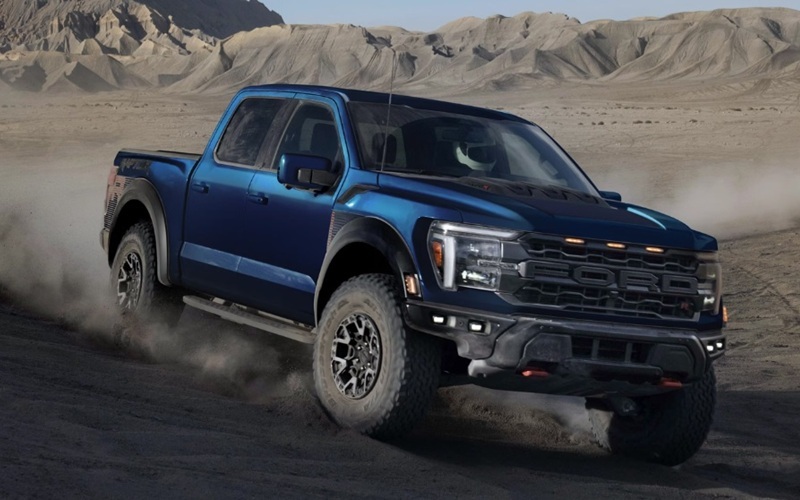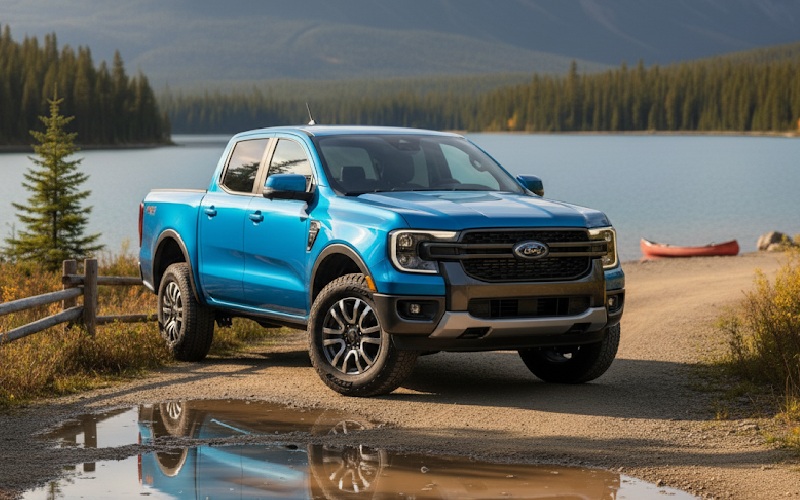The Ford Ranger offers a carefully curated selection of powertrain options, each engineered to deliver the right balance of performance, efficiency, and capability for different customer needs. From the standard EcoBoost four-cylinder to specialized performance variants and emerging electrified options, the Ranger engines showcase the Ford commitment to providing diverse powertrain solutions in the mid-size truck segment.

2.3L EcoBoost: The Versatile Foundation
The cornerstone of the Ranger lineup remains the proven 2.3L EcoBoost four-cylinder engine, which serves as the standard powerplant across most trim levels. This turbocharged engine delivers an impressive balance of power and efficiency that makes it well-suited to the mid-size truck segment.
The 2.3L EcoBoost generates 270 horsepower at 5,500 rpm and 420 Nm of torque at a low 2,500 rpm. This substantial torque output at relatively low engine speeds provides excellent acceleration from standstill and strong pulling power for towing applications. When properly equipped, Rangers with this engine can tow up to 3,402 kg, positioning it among the class leaders for towing capability.
The engine features direct fuel injection, twin-scroll turbocharging, and an aluminum block and head design to reduce weight while maintaining durability. Variable valve timing optimizes performance across different operating conditions, while the integrated exhaust manifold improves thermal efficiency during warm-up periods.
Ford pairs this engine exclusively with its advanced 10-speed automatic transmission across all configurations. This transmission features optimized gear spacing for improved acceleration and efficiency. It has unique shift programming that adapts to driving conditions, load, and terrain grade to keep the engine in its optimal power band.
Fuel efficiency remains impressive for a mid-size truck, with ratings of approximately 10.7 L/100 km in city driving and 8.4 L/100 km on highways for 4×2 models. The 4×4 variants show a modest consumption increase to approximately 11.2 L/100 km city and 9.0 L/100 km highway.
The 2.3L EcoBoost engine is available across XL, XLT, Sport, and Lariat trims in 4×2 and 4×4 configurations, making it the most versatile and widely available powerplant in the Ranger lineup.
3.0L EcoBoost V6: High-Performance Heart
Exclusive to the Ranger Raptor, the twin-turbocharged 3.0L EcoBoost V6 engine represents the performance pinnacle of the Ranger lineup. Ford Performance has engineered this specialized powerplant to deliver exceptional output and durability under the demanding conditions the Raptor is designed to conquer.
The 3.0L EcoBoost V6 produces an impressive 405 horsepower at 5,650 rpm and 583 Nm of torque at 3,500 rpm, substantially increasing over the standard 2.3L engine. This significant power boost transforms the Ranger character, enabling high-speed desert running capabilities and effortless highway overtaking.
Technical highlights include a compacted graphite-iron cylinder block that offers increased strength and durability compared to conventional iron or aluminum blocks. This specialized material allows for thinner cylinder walls without compromising structural integrity, reducing overall engine weight while maintaining robust durability for off-road impacts.
The twin-turbocharging system employs a unique anti-lag system derived from Ford motorsport programs. When activated in Baja mode, this system keeps the turbochargers spinning for up to three seconds after the driver lifts off the throttle, ensuring immediate response when power is requested again – a crucial feature for high-speed off-road driving where momentum is essential.
The Raptor’s 3.0L EcoBoost pairs with the same 10-speed automatic transmission used across the Ranger lineup, but with specialized calibration to handle the increased power output and performance-oriented driving scenarios. Strengthened internal components and revised shift logic optimize performance both on and off-road.
A true dual-exhaust system with electronically controlled valves enables the driver to select different exhaust sound profiles, from a quiet mode suitable for early morning departures to a full-throated performance setting that amplifies the engine’s character during spirited driving.
Fuel efficiency takes a back seat to performance in the Raptor application, with consumption ratings of approximately 14.7 L/100 km in city driving and 11.2 L/100 km on highways. However, these figures remain reasonable considering the substantial performance capabilities this engine delivers.
2.0L Bi-Turbo Diesel: Torque and Efficiency
Select markets receive an updated version of the Ford 2.0L Bi-Turbo diesel engine, offering an appealing combination of torque and fuel efficiency for those who prioritize these attributes.
This sophisticated diesel powerplant employs a sequential bi-turbo system that uses a small, low-inertia turbocharger for immediate response at lower engine speeds, working in conjunction with a larger turbocharger that provides maximum airflow at higher rpm. This arrangement delivers consistent torque throughout the rev range without the lag typically associated with large single-turbocharger designs.
Output figures stand at 210 horsepower at 3,750 rpm and an impressive 500 Nm of torque available from just 1,750 rpm. This substantial torque output provides excellent towing capability and effortless acceleration, particularly when carrying heavy loads.
Like its gasoline counterparts, the diesel engine pairs exclusively with a 10-speed automatic transmission. However, the transmission receives unique calibration to leverage the diesel’s different power delivery characteristics, with shift points optimized to keep the engine in its torque sweet spot.
Fuel efficiency represents the diesel’s strongest advantage, with ratings of approximately 9.0 L/100 km in city driving and 7.1 L/100 km on highways for 4×2 models. Even 4×4 variants maintain impressive efficiency, consuming approximately 9.4 L/100 km in city environments and 7.6 L/100 km during highway cruising.
The diesel option is available on XLT and Lariat trims, providing a compelling alternative for buyers who regularly tow heavy loads or prioritize maximizing range between refuelling stops.
Hybrid Powertrain: Electrified Evolution
New this year is the Ranger PowerBoost hybrid option, representing the first electrified Ford offering in the mid-size truck segment. This system adapts technology from the successful F-150 PowerBoost, scaled appropriately for the Ranger platform.
The PowerBoost system pairs the standard 2.3L EcoBoost engine with a 35 kW electric motor integrated into the 10-speed automatic transmission. A 1.5 kWh lithium-ion battery mounted beneath the rear seats provides energy storage without compromising interior or cargo space.
Combined system output reaches 320 horsepower and 515 Nm of torque, positioning the hybrid as the second most powerful option in the Ranger lineup behind only the Raptor. The electric motor provides immediate torque from standstill, enhancing acceleration response and smoothing power delivery in stop-and-go traffic situations.
Beyond performance enhancements, the hybrid system delivers significant efficiency improvements, particularly in urban driving environments where regenerative braking and electric-only operation maximize efficiency. Preliminary fuel consumption ratings indicate approximately 8.7 L/100 km in city driving and 7.8 L/100 km on highways for the 4×2 configuration.
The PowerBoost system’s standout feature is the Pro Power Onboard generator functionality, which transforms the Ranger into a mobile power source. With 2.4 kW of exportable power available through cabin and cargo box outlets, the system can run tools, camping equipment, or other accessories off the integrated battery system.
The hybrid powertrain is available on XLT, Sport, and Lariat trims in 4×2 and 4×4 configurations, offering a compelling blend of efficiency and utility for buyers who value these attributes.
Performance Across the Lineup
The diverse engine options create distinct performance profiles across the Ranger lineup:
Standard 2.3L EcoBoost (XL, XLT, Sport, Lariat)
- 0-100 km/h acceleration: approximately 6.9 seconds (4×2), 7.2 seconds (4×4)
- Towing capacity: up to 3,402 kg when properly equipped
- Payload capacity: up to 921 k, depending on configuration
PowerBoost Hybrid 2.3L (XLT, Sport, Lariat)
- 0-100 km/h acceleration: approximately 6.5 seconds (4×2), 6.8 seconds (4×4)
- Towing capacity: up to 3,175 kg when properly equipped
- Payload capacity: up to 862 kg (reduced slightly due to battery weight)
2.0L Bi-Turbo Diesel (XLT, Lariat)
- 0-100 km/h acceleration: approximately 7.9 seconds (4×2), 8.2 seconds (4×4)
- Towing capacity: up to 3,402 kg when properly equipped
- Payload capacity: up to 944 kg, depending on configuration
3.0L EcoBoost V6 (Raptor)
- 0-100 km/h acceleration: approximately 5.8 seconds
- Towing capacity: 2,722 kg (reduced due to off-road suspension tuning)
- Payload capacity: 793 kg (reflects specialized off-road configuration)
Engine Technology Highlights
Several key technologies distinguish the Ford Ranger powertrain offerings:
Auto Start-Stop Technology is standard across all engine options, reducing fuel consumption and emissions during idle periods such as traffic lights or drive-through queues. The system is calibrated to maintain comfort with imperceptible restarts. It includes intelligent monitoring that prevents activation when continuous engine operation is beneficial, such as towing or traversing rough terrain.
Advanced Thermal Management systems optimize engine operating temperatures across all powertrains, with active grille shutters that reduce aerodynamic drag at highway speeds while opening to maximize cooling during heavy-duty operation. The PowerBoost hybrid features additional cooling circuits to maintain ideal battery temperatures across extreme operating conditions.
Cylinder Deactivation technology in the 3.0L EcoBoost V6 can seamlessly disable three cylinders during light-load conditions, improving fuel efficiency without compromising throttle response when power is demanded. The transition between three and six-cylinder operation occurs in milliseconds, remaining imperceptible to drivers.
Transmission Technology
All Ford Rangers utilize the sophisticated Ford 10-speed automatic transmission, featuring specific calibrations for each powertrain application. The transmission control module continuously adapts shift patterns based on driving style, load conditions, and terrain, keeping each engine in its optimal power band.
SelectShift® manual mode allows drivers to override automatic operation when desired, with steering wheel-mounted paddle shifters standard on Sport, Lariat, and Raptor models. The system permits full manual control while incorporating protective overrides to prevent engine damage.
The PowerBoost hybrid integrates its electric motor directly into the transmission housing, enabling seamless transitions between power sources without requiring additional space or weight. This integration maintains the proven Ranger 10-speed architecture while adding electrified capability.
Terrain Management System
The available Terrain Management System optimizes powertrain response across diverse driving environments. On 4×4 models, drivers can select from up to seven drive modes that adjust throttle mapping, transmission shift points, and traction control parameters:
- Normal: Balanced settings for everyday driving
- Eco: Prioritizes efficiency with earlier upshifts and reduced throttle sensitivity
- Sport: Sharpens throttle response, holds gears longer, and increases steering weight
- Slippery: Reduces throttle sensitivity and adjusts traction control for wet or icy conditions
- Mud/Ruts: Optimizes torque delivery and engages 4H for navigating muddy terrain
- Sand: Maintains higher engine speeds and adjusts shift patterns for loose surfaces
- Tow/Haul: Reduces gear hunting, improves engine braking, and adjusts cooling system priorities
The Raptor adds Baja mode, specifically engineered for high-speed off-road performance with anti-lag turbocharging, optimized damper settings, and reduced traction control intervention.
2025 Ford Ranger: Powertrain Versatility for Every Need
The diverse Ford Ranger powertrain lineup demonstrates the Ford commitment to providing specialized solutions for varied customer requirements. From the efficient yet capable standard EcoBoost to the desert-conquering Raptor V6 and forward-looking hybrid option, each engine delivers a distinct character while maintaining the durability and capability expected from Ford trucks.
With class-competitive towing, impressive efficiency, and purpose-built performance variants, the Ford Ranger powertrain options ensure customers can select the ideal configuration for their specific work, adventure, and daily driving needs.






